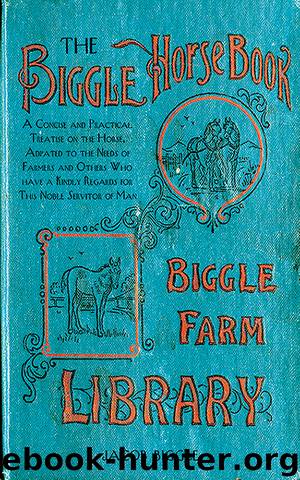The Biggle Horse Book by Jacob Biggle

Author:Jacob Biggle
Language: eng
Format: epub
Publisher: Skyhorse
Published: 2012-12-31T16:00:00+00:00
NEVER SICK A DAY IN HIS LIFE.
CHAPTER VIII.
DOCTORING.
Giving Medicine—Medicine Ball—Injections—Physic—Condition Powders—Ending a Horse’s Life.
Many inexperienced horsemen know nothing of how to give a horse medicine. Some who can administer a drench have never tried balling. Many get bitten who try, so it is best to be careful. Hold the head high, reach the fingers into the animal’s mouth just back of the forward teeth where there are no teeth, and no danger of being bitten, and grasp the tongue, pull it out gently, and as you do so the horse will open his mouth, allowing the tongue to loll between the grinders. The medicine ball may then be safely pushed down the animal’s throat as far as the hand can be made to reach, for the animal will not attempt to close his jaws while his tongue is between them. Two persons, one to administer the medicine, while the other is holding the tongue and head, will accomplish the desired object more quickly. The throat should be watched carefully, and the animal not be allowed to lower his head until he is seen to swallow. The tongue should be pushed back into his mouth as soon as the ball is put well down the throat, as it will assist in the swallowing process. Horse balls usually come wrapped in tissue paper, and should not be unwrapped before administering, as it prevents bad taste in the mouth.
The giving of a drench is so easy and common as not to need description. The medicine should be shaken well with half a pint of water, and poured into a wide-mouthed heavy glass bottle that the horse cannot easily crush. Having secured the head and tongue as described in “administering a ball,” turn up the bottle in the horse’s mouth, holding the head so the contents will run down his throat. Remove the bottle after pouring in about four ounces. If he does not swallow at once, gently close the nostrils for a moment, or tickle the roof of his mouth with the finger nail. This will cause him to move the tongue and before he knows it he will have swallowed the mixture. If coughing occur or the bottle be crushed, lower the horse’s head immediately.
Injections should be small in quantity when for absorption, and at a temperature of 90 to 100 degrees. They should be introduced only after the last bowel has been emptied by hand or by copious enemas. Clysters are given usually to aid the action of physics, and should be in sufficient quantity to cause the animal to eject them. Warm water, salt and water, or soap and water, one gallon or more at a time may be given every half hour. It is best that they be not discharged immediately. Liquids may be injected by means of a large syringe, or by a simple funnel made for the purpose of a two-quart pail or pan seven inches in diameter, to which a pipe sixteen inches long is soldered at right angles.
Download
This site does not store any files on its server. We only index and link to content provided by other sites. Please contact the content providers to delete copyright contents if any and email us, we'll remove relevant links or contents immediately.
| Riding | Showing & Training |
Finding Gobi by Dion Leonard(2260)
Grumpy Cat by Grumpy Cat(2121)
The Silkworm by Robert Galbraith(1999)
A New Earth: Awakening to Your Life's Purpose by Eckhart Tolle(1974)
End of Days by Sylvia Browne(1824)
Tippi by Tippi Hedren(1766)
Total Cat Mojo by Jackson Galaxy(1688)
Backyard Chickens Beyond the Basics by Pam Freeman(1618)
The Animals Among Us by John Bradshaw(1508)
The Ultimate Pet Health Guide by Gary Richter(1431)
Vet in Harness by James Herriot(1387)
Cesar's Way by Cesar Millan(1366)
Dog Years by Mark Doty(1365)
Doggy Desserts: 125 Homemade Treats for Happy, Healthy Dogs by Cheryl Gianfrancesco(1360)
All Things Bright and Beautiful by James Herriot(1304)
Chicken Soup for the Ocean Lover's Soul by Jack Canfield(1289)
Walking with Peety by Eric O'Grey(1286)
Dog Training 101 by Kyra Sundance(1262)
Encyclopedia of Dog Breeds by D. Caroline Coile Ph.D(1178)
